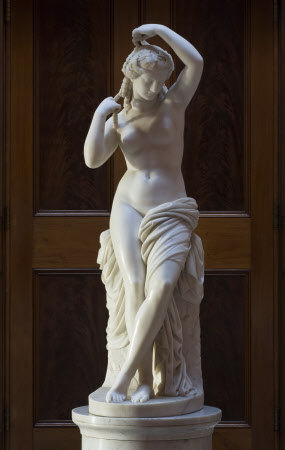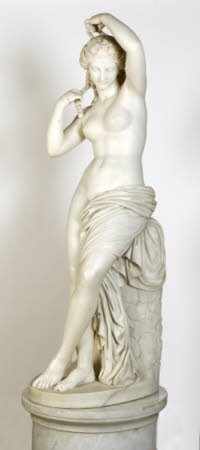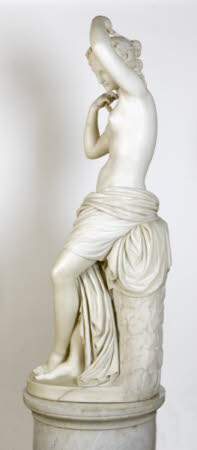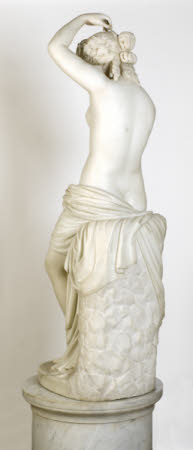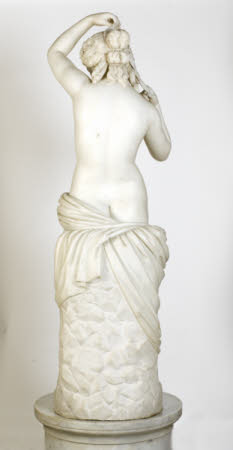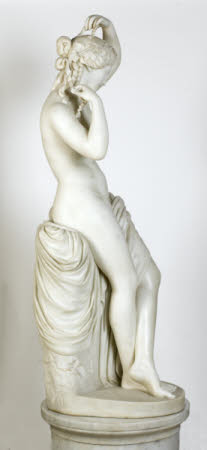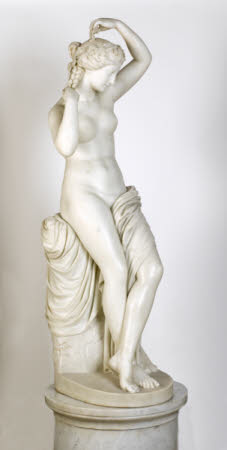A Bacchante tying her hair
Lawrence MacDonald (Scotland 1799 - Rome 1878)
Category
Art / Sculpture
Date
1856
Materials
Carrara marble
Measurements
1549 x 457 mm; 584 mm (Diameter)
Place of origin
Rome
Order this imageCollection
Mount Stewart, County Down
NT 1221034.1
Summary
Sculpture, marble; Bacchante tying her hair; Laurence MacDonald (1799-1868); 1856. A full-size marble statue of a naked woman, leaning against a tree trunk, doing up her hair. The ivy leaves in her hair suggest she is a bacchante, a female follower of the god of wine, Bacchus. One of two large sculptures of ideal subjects by MacDonald, acquired for the Black and White Hall at Mount Stewart.
Full description
A full-sized standing figure in whitre marble of a young woman, identifiable from the ivy leaves in her hair as a bacchante, a follower of Bacchus, god of wine. She leans casually backwards, her left leg crossed over the right, half-seated on a rocky column, over which is spread at the top the end of a swag of drapery, the other end of which passes round her waist and over her left leg, to fall towards the ground. With her hands she ties up her hair with a ribbon, forming a bow at the back. On an integral oval base, at the back of which is the artist’s signature and the date. Set upon a grey marble circular pedestal. A pair to MacDonald’s Venus after the Bath (NT 1221033). Laurence MacDonald was one of a generation of talented Scottish sculptors who led a small renaissance in the art of carving in Scotland in the early nineteenth century. He began his career working in Perth as a mason before moving to Edinburgh in 1822 where, however, he only remained for a few months, before leaving for Rome, where he arrived shortly after the death of Antonio Canova. MacDonald spent the next four years in Rome, living from portrait commissions, before returning in 1826 to Edinburgh, where he set up his studio. During the next few years MacDonald’s reputation grew, to the extent that he was even hailed by the Edinburgh Literary Journal in 1830 as ‘our Canova’. However, despite success in Edinburgh and in London, in 1832 he decided to return to Rome, where he settled for the remainder of his life and developed a flourishing practice, assisted by his brother John and, from the 1860s, his son Alexander (see NT 1139716). In 1844, in a sign of his growing status, MacDonald took over the lately deceased Danish sculptor Bertel Thorvaldsen’s former studio in the Piazza Barberini. By the 1850s, the decade when the two full-sized figures at Mount Stewart were made, a visit to Laurence MacDonald’s studio had become all but obligatory for cultured British tourists, many of whom commissioned their portraits from the sculptor. As one commentator wrote in 1852, ‘This artist’s studio is a real British Walhalla. It contains upwards of 300 busts of the British nobility and the most celebrated men of the day’ (Morning Chronicle, 19 February 1852). For Laurence MacDonald, as for many sculptors, portraits were an expedient way to earn a living, but he preferred to make ‘ideal’ statuary and seized all opportunities to do so. The Bacchante is not based on a specific Roman prototype but shows awareness of Greek and Roman sculptures of Aphrodite (Venus), goddess of love. The drapery recalls sculptures of the so-called Venus pudica in which the goddess holds a drapery to cover her genitals, whilst other sculptures of Venus show her with her arms raised, arranging her hair. Although probably coincidental, MacDonald’s elegant and relaxed figure also recalls quite strongly small bronze figures by Barthélémy Prieur (c. 1536-1611), in which young women are depicted seated and dressing their hair or otherwise attending to their appearance. An example is at Anglesey Abbey (NT 515010). Laurence MacDonald’s Bacchante was a successful model for the sculptor. It was listed as early as 1841 in the catalogue of his works published by Count Hawks Le Grice, in his 'Walks through the Studii of the Sculptors at Rome' (I, p. 82). In 1842 MacDonald exhibited a version in marble at the Royal Academy (no. 1293), along with a statue of Hyacinth (no. 1294). This Bacchante seems likely to be the version in a private collection, made in 1842 and presented as a gift to the Oliphant family of Gask, who had been instrumental in helping the young MacDonald launch his career (Pearson 1991, pp. 68 and 71, fig. 65). A version was being completed in MacDonald’s studio in Rome in February 1852, commissioned by Lord Kilmorey (Morning Chronicle, 19 February 1852), whilst another was made for Lord Ward and was exhibited at the Manchester Art Treasures exhibition held in 1857; yet another version was formerly at Wentworth Woodhouse. A version was lent by Charles Jenner to the Royal Scottish Academy exhibition in 1865 and again in 1880. A version, signed and dated 1862 and without a recorded provenance to one of these collections was recently sold at auction (Sotheby's London, 19th and 20th century sculpture, 12 July 2023, lot 46). The version now at Mount Stewart was acquired in the late 1850s for the house by the 4th Marquess of Londonderry, presumably directly from the artist. The Londonderrys certainly visited MacDonald in the later 1850s, since formerly at Londonderry House was a portrait bust of Mary Cornelia, 4th Marchioness of Londonderry, made in Rome and signed and dated 1859 (Londonderry House 1939, p. 144). Jeremy Warren September 2022
Provenance
Acquired by Frederick Vane, 4th Marquess of Londonderry (1805 -1872); by descent; Lady Mairi Bury (1921-2009), by whom given to the National Trust in 1976.
Marks and inscriptions
Back of base: L. MACDONALD. FECIT. / ROMÆ. 1856
Makers and roles
Lawrence MacDonald (Scotland 1799 - Rome 1878), sculptor
References
Mount Stewart 1950: Inventory and Valuation of the Contents of Mount Stewart, Newtownards, County Down, the property of the Marchioness Dowager of Londonderry, D.B.E. Prepared for the purpose of insurance by H. Clifford-Smith, M.A. F.S.A. 1950, p. 3. Le Grice 1841: Count Hawks Le Grice, Walks through the Studii of the Sculptors at Rome, 2 vols., Rome 1841 Londonderry House 1939: A Catalogue and Valued Inventory of the Furniture and Works of Art at Londonderry House, Park Lane, W... Prepared for the purposes of insurance, with historical notes, by H. Clifford-Smith, 1939 Pearson 1991: Fiona Pearson, ed.: Virtue and Vision. Sculpture and Scotland 1540-1990, exh. cat., Royal Scottish Academy, Edinburgh 1991 Roscoe 2009: I. Roscoe, E. Hardy and M. G. Sullivan, A Biographical Dictionary of Sculptors in Britain 1660-1851, New Haven and Yale 2009, pp. 777-78, nos. 13, 22, 33.
